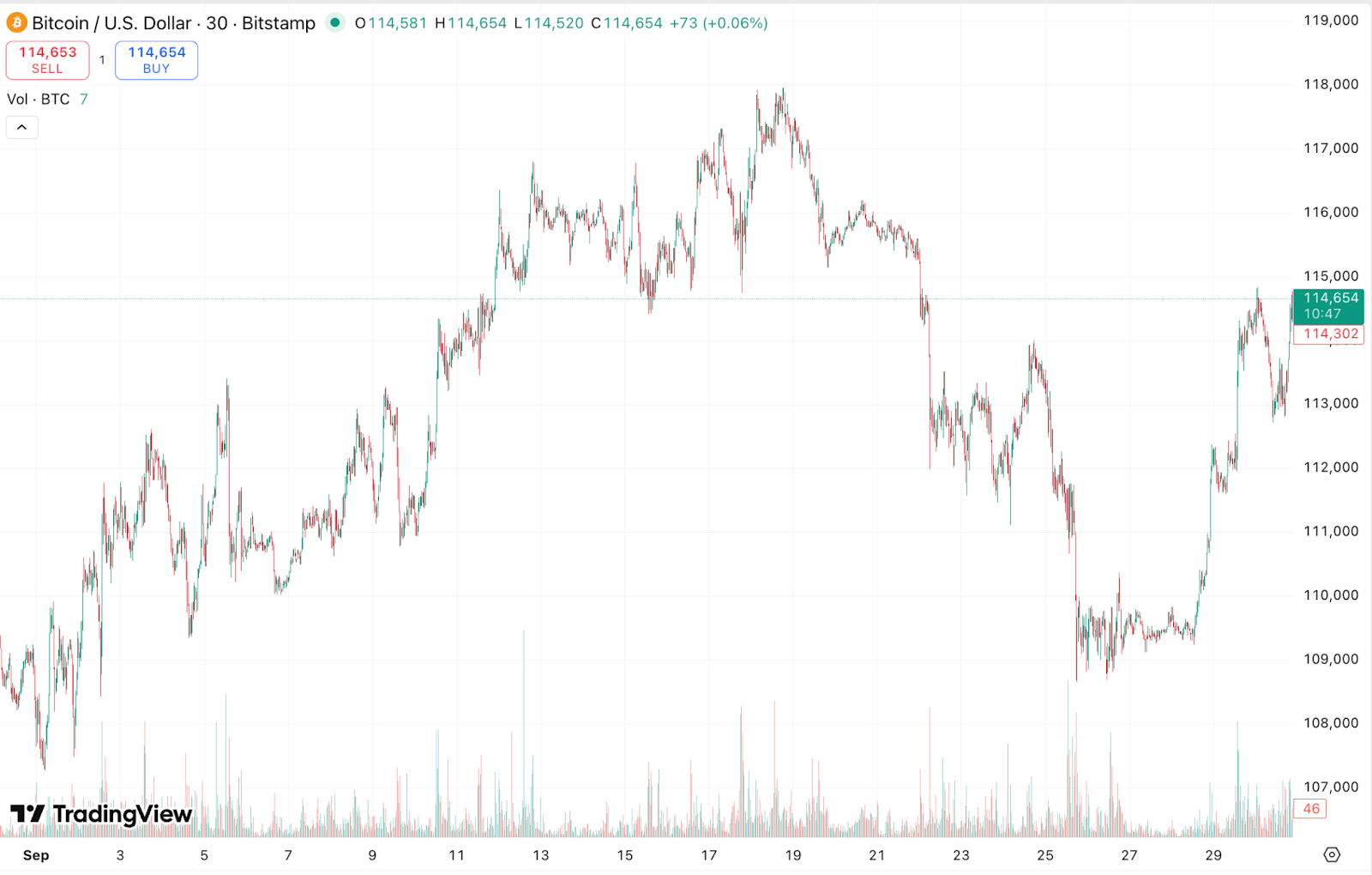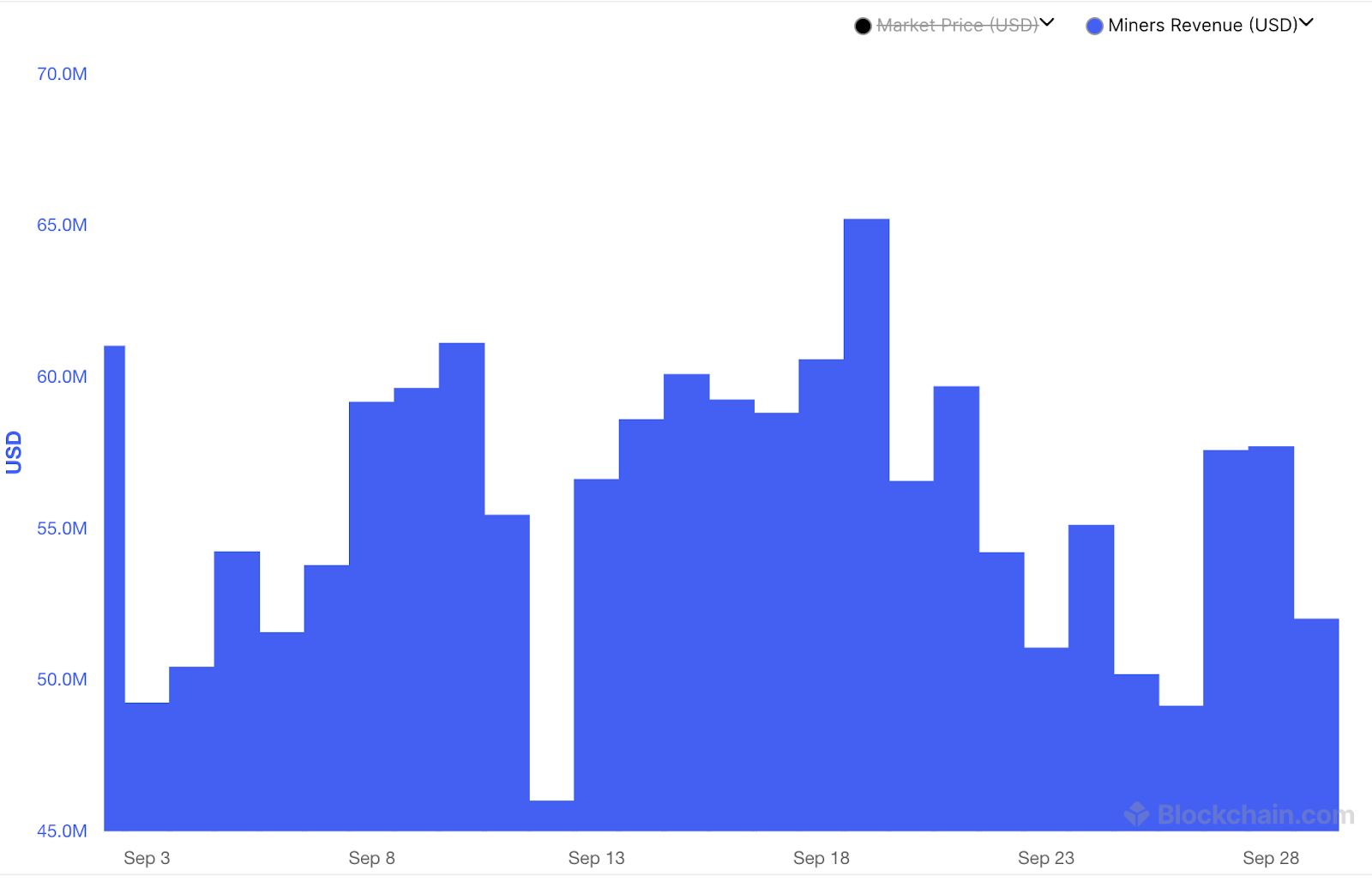
Bitcoin ended September at $114,624, marking a slight monthly gain from $108,369 at the start. Price action remained volatile, with swings between $ 108,000 and $ 117,000 driven by shifting institutional flows, regulatory signals, and global macroeconomic factors. Meanwhile, miner revenue held steady after the mid-August drop, and hashrate fluctuated across a broader range than in previous months. Market sentiment cooled slightly but remained in the greed zone. Substantial accumulation from long-term holders, record mining difficulty, and a coordinated US regulatory framework signalled continued strength in Bitcoin’s fundamentals.
Bitcoin opened September at $108,369 and rose to $112,587 by September 3, fuelled by early optimism around macro policy clarity and investor repositioning after August’s volatility. The climb continued with a modest gain to $113,362 on September 5, before dipping to $111,560 on September 7, a reaction to renewed selling pressure in risk markets and a brief pullback in tech stocks, which were holding Bitcoin.
By September 9, Bitcoin had recovered to $113,236. On September 10, Reuters reported a decline in MicroStrategy’s shares and a broader correction in Bitcoin-linked equities, briefly weighing on sentiment. However, the market regained ground quickly. On September 11, Bitcoin reached $114,714, with gains continuing to $116,066 on September 13. The recovery was supported by regulatory clarity following the SEC's outline of digital asset-inclusive reforms in its fall agenda (Reuters, Sept. 11), which boosted institutional confidence.
The asset saw a minor dip to $114,931 on September 15 before jumping to $117,959 by September 18. That rally followed Reuters reporting on the SEC’s approval of new listing rules for spot digital asset ETFs (Sept 18), making it easier for fund managers to enter the market. Prices held relatively firm at $115,886 on September 20 but declined to $112,083 on September 22, coinciding with broader market caution despite positive developments.
On September 22, Reuters reported the US and UK had formed a joint working group to align digital asset regulation, reinforcing long-term optimism. Bitcoin held steady at $113,957 on September 24, but dropped to a monthly low of $108,784 on September 26 as short-term traders took profit and risk sentiment cooled.
The month ended with a recovery to $112,317 on September 29 and $114,624 on September 30, closing September higher than where it started. The rebound reflected strong underlying demand and institutional resilience despite brief volatility.

The month began at a strong baseline of 957.4 EH/s on 1 September before dropping to 848.3 EH/s by 3 September. A short recovery followed, reaching 872.9 EH/s on the 4th. A significant spike occurred on 7 September, pushing the hashrate to 1.1524 ZH/s, followed by further strength on 9 September at 1.2102 ZH/s.
After this rise, the network returned to 971.5 EH/s by 11 September and then dropped sharply to 833.3 EH/s on 13 September. This was followed by a quick rebound to 1.1434 ZH/s on the 15th, before declining again to 836.4 EH/s on 17 September.
On 19 September, the network spiked to 1.1770 ZH/s, leading into the monthly high of 1.4056 ZH/s on 20 September — the highest hashrate observed this month. This was followed by a sharp correction back to 970.5 EH/s on 22 September. A moderate rebound occurred around 24 September at 1.1284 ZH/s, holding steady around 1.1174 ZH/s on 26 September.
By 30 September, the hashrate settled at 1.0149 ZH/s, closing the month at a higher level than it began, suggesting robust miner participation and network security despite mid-month volatility.

Bitcoin miners began the month with a substantial daily revenue of around $61 million on September 1st, but this quickly dropped to below $50 million by September 2nd. From there, miner earnings began a steady climb, fluctuating between $50 million and $55 million through the first week.
Between September 7th and 11th, revenue rose consistently, peaking at around $62M, reflecting both improved network activity and price movements. However, this was followed by a sharp one-day dip on the 13th, briefly falling near $45M — the lowest level of the month. The drop appears to be temporary, as revenues rebounded quickly from the 14th onward.
From the 15th to the 19th, daily miner revenue remained high, consistently between $58M and $65M, with the 19th of September marking the monthly peak at over $66M. Both increased transaction fees and higher hashrate stability likely supported this period of strength.
After the peak, miner income declined slightly, though still remained within a healthy $55M–$60M range until the 22nd, before dropping to around $50M by the 24th. Another brief dip occurred near $47 million on the 26th, before recovering again to just over $55 million by the 28th. The month closed with a final drop, as miner revenue fell to around $50 million on the 30th.

In September, the average prices in the Bitcoin mining industry (according to ASIC Miner Value) were:
Bitmain Antminer S19j Pro+ (122TH/s)= $2,394
Bitmain Antminer S19 XP Hyd (257TH/s)= $2,366
MicroBT Whatsminer M50S (128Th/s) = $1,733
Institutional investment grows: U.S. spot Bitcoin ETFs reached $110 billion in assets under management by the end of September, reinforcing Bitcoin’s position in structured portfolios.
Companies continue to accumulate: Tether purchased 8,888 BTC during Q3 2025 at an average price of $112,500, raising its total holdings to over 87,000 BTC. This supports the use of Bitcoin as a reserve asset.
The regulatory approach becomes clearer: The SEC and CFTC have announced a coordinated plan for digital asset regulation. This included efforts to clarify trading rules and the possibility of expanding market hours.
On-chain data signals strong activity: Long-term holders added 298,000 BTC in September. The Stablecoin Supply Ratio indicated that Bitcoin was undervalued, a metric often associated with accumulation phases.
Network security improves: Bitcoin’s mining difficulty reached 134 trillion, marking the highest level to date. This reflects more capital entering mining and stronger infrastructure overall.
The contents of this analysis are for informational purposes only and do not constitute investment advice. The study is based on the author's opinions and assumptions and may not reflect the actual state of the market or the future outcomes of any investment. The author is not a financial advisor and assumes no responsibility for the information's accuracy, completeness, or suitability.
Bitcoin investments are subject to high risks and volatility. The prices can fluctuate significantly due to factors such as supply and demand, regulatory actions, technological innovations, security breaches, hacking attacks, market sentiment, and global events.
Investors should be aware of these risks and conduct their diligence before making investment decisions.



